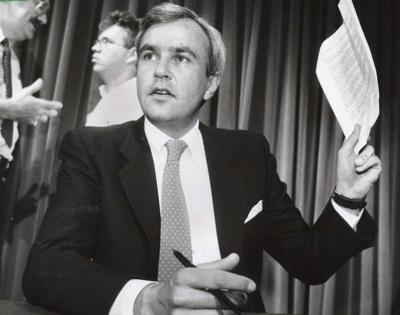There must be something about the spring air in Canada. Something political, that is.
WeŌĆÖve just concluded a critical federal election. This month╠²also marks the anniversary of another momentous spring vote in CanadaŌĆÖs most populous province ŌĆö an election which overturned a dynasty, brought political plurality to the province, led to sweeping policy modernization, and established new rights and representation for marginalized groups.
When Progressive Conservative Premier Frank Miller called an election for May 2, 1985, his party had governed Ontario for a remarkable 42 years.
Few expected that to change. The Tories went into the fight with a 20-point polling lead.
While Liberal Leader David Peterson had built a strong reputation in opposition, most observers expected a solid but uninspiring campaign.
Instead, PetersonŌĆÖs youth ŌĆö he was 42 ŌĆö energy, and progressive ideas struck a chord with the public, in contrast to Miller, who was 58 and best known for his plaid jackets and folksy manner.
As the campaign unfolded, Liberals were buoyed by PetersonŌĆÖs performance as he rolled out a progressive platform.
Photos of the Liberal leader smiling at a Jamaican patty shop in Kensington Market or jogging through Windsor contrasted with the PCŌĆÖs low-bridge campaign. Miller refused to debate and drew sparse crowds. Still, few expected the stunning results of May 2.
The Liberals won the popular vote, with 37.9 per cent support to the PCŌĆÖs 37.2 per cent, though the PCs took 52 seats (down from 70) to the Liberals 48. The NDP trailed at 23.6 per cent and 25 seats.
The Liberals and NDP soon negotiated ŌĆ£an agenda for reformŌĆØ which spelled out actions a Liberal government would implement, based on common campaign planks, and defeated the Miller government on a motion of confidence.
On June 26, in brilliant sunshine on the lawn of the Legislature, David Peterson was sworn in as the 20th Premier of Ontario.
Two years later, the Liberals would romp to the largest majority government in OntarioŌĆÖs history.
Yet, by September 1990, it was all over, as voters turned thumbs down on a self-serving early election call and PetersonŌĆÖs focus on the Meech Lake constitutional accord.
The Peterson government is remembered largely for that rapid arc from upset to landslide to collapse.
Yet, the 1985 election changed party dynamics in Ontario for good.
Since then, there have been 20 years of Liberal government, 15 years (and counting) of Conservative rule and five years of NDP.
And during five years of activism, the Peterson Liberals reshaped the province.
They passed OntarioŌĆÖs first freedom of information and protection of privacy legislation, banned extra billing by doctors, fostered the creative boom of ŌĆ£Hollywood North,ŌĆØ and implemented full funding to Catholic schools.
They strongly supported workers and unions through first-contract legislation, workersŌĆÖ compensation expansion, and pension reforms.
To foster innovation and wealth creation, Peterson set up a PremierŌĆÖs Council with a $1-billion Technology Fund, created academic centres of excellence, and drove trade expansion to Asia and Europe to counterbalance the federal free trade push with the U.S.
Peterson and Treasurer Bob Nixon brought in OntarioŌĆÖs first balanced budget in 20 years.
Environment Minister Jim Bradley led historic environmental reforms, including the spills bill, the acid rain control program, the blue box, and air and water emission controls.
The new government reflected OntarioŌĆÖs diversity, appointing the provinceŌĆÖs first black and first female Jewish ministers, CanadaŌĆÖs first Chinese-Canadian minister, and the first Indigenous and South Asian deputy ministers. It vastly expanded the number of women in senior public service roles and appointments, introduced human rights protections for sexual orientation, and established equal pay for work of equal value.
It spread the benefits of government outside of Toronto, moving more than 1,200 permanent high-paying jobs to northern Ontario and the headquarters of Agriculture and Food to Guelph.
It put an end to a patronage system so rampant that every job from the clerks in the LCBO to the highest positions in government required party fealty.
The legacy of this innovative period in Ontario history still resonates in rights, freedoms, laws, and programs that we now consider so fundamental, we take them for granted.
With diversity, equity and inclusion under fire, the need to broaden world trade is more essential than ever in the face of U.S. nationalist retrenchment, and research-driven innovation is critical to success in the AI world. There is much to gain from building on the legacy of an extraordinary five years that began 40 years ago this month.




























To join the conversation set a first and last name in your user profile.
Sign in or register for free to join the Conversation